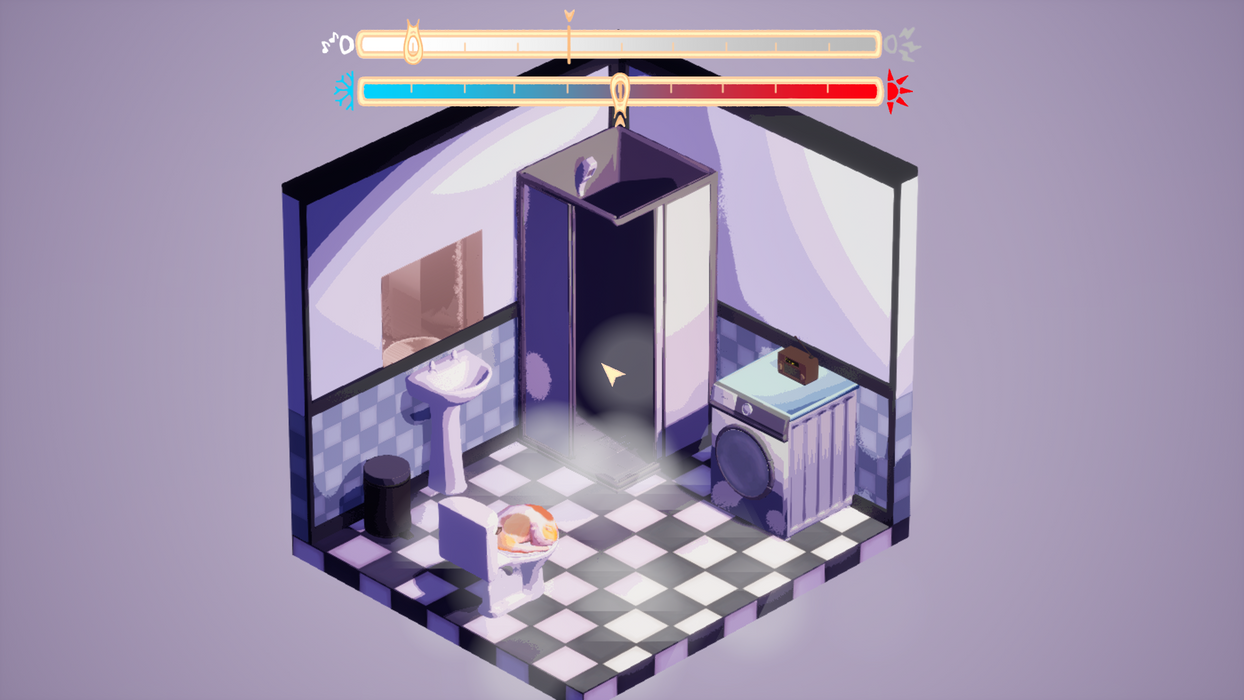
UE 5
Sleepy Kitty
Released December 2024
Sleepy Kitty is a cozy relaxing isometric puzzle game about putting a kitty to sleep.



2
3 weeks
About
Sleepy Kitty is a 5-10 minute cozy relaxing isometric puzzle game about putting a kitty to sleep. The player's goal is to interact with the environment of the room to align the meters to the preferred conditions of the cat.
Puzzles
The puzzles are short, simple, and intuitive suitable for a wide player audience, and focus more on the game experience rather than on problem solving.
Atmosphere
The game focuses on bringing a cozy, calming, and relaxing player experience. All developed features were made in mind with the atmosphere that they create, and the feeling all interactions bring.
Visuals
The visuals are simple, but aesthetically pleasing, maximizing the quality we could achieve in a small amount of time.
.png)
Role and Contribution
Game Designer
-
Designed and Integrated:
-
Camera and controls.
-
Stress systems, which determine the win state for the level.
-
Over 10 level mechanics, such as fireplace, radio, windows, kettle, etc.
-
10 short levels.
-
UI/UX
-
-
Implemented over 25 sound effects.
-
Developed shaders, visual effects, and textures.
-
Collaborated with a visual artist, assisted with some of the 3d models, and set-dressed the scene.
-
Playtested and iterated on the game to fit the intended player experience.
Stress Systems
Interactive
What
The level mechanics are split up into groups based on the meter they affect:
-
Only temperature: fireplace, fan, fridge
-
Only noise: radio, TV, vacuum, windchimes
-
Temperature and noise: window, kettle, shower
Each mechanic has a unique way to interact with it, some as simple as clicking on it, and some have a small mini-game (ex: refilling the fireplace).
Why
-
Higher loop: The player must find the right combination of settings to get the correct value on the meters. As the game progresses, new mechanics are introduced, and finding the right value slowly becomes harder.
-
Lower loop: Figuring out how to use each mechanic is a smaller puzzle. As the game progresses, the player must start thinking outside the box as mechanics such as the vacuum and the shower require more creative approaches.
The combination of these two gameplay loops keeps the player entertained for the short duration of the game.
How
-
The mechanics have a modular setup, it determines the state it starts in (ex: open or closed window, specific radio or TV channel) and the heat/noise it exerts at other states.
-
The mechanics are activated via an interaction system that checks for currently hovered objects via line tracing. Once the player performs the required input, the object's function is activated via an interface.
Physics Based
What
The fan is a unique mechanic in the game, it makes the objects it points at move around, and fly off using physics.
This applies not only to different set pieces like cups and vases but also to some level mechanics such as the shower handle or windchimes which get activated by pointing the fan at them.
Why
-
Moving around set pieces in the level adds a layer of depth to the game. It is a fun satisfying gesture that contributes to the intended player experience.
-
This feature is also a part of the puzzles: the player needs to blow objects onto the vacuum to turn it off and blow at the shower handle to make it fall and break.
How
-
When the player rotates the fan and its current overlaps with movable objects in the level, it enables their physics and applies force to them making them move away from the fan. Alternatively, it activates the level mechanic that requires the fan to function.
-
All fan interactions are done via a separate interface. The speed/force at which the objects move is determined by their mass.
Level Mechanics
Audio

Audio Snippet
What
Over 25 sound effects have been implemented:
-
Sounds for every mechanic, every button, every interaction, and every level transition.
Why
-
The sound improves the immersion of the game and contributes to the relaxing player experience.
-
The sound serves as feedback for mechanics and for clues to what the player is doing wrong. For example, if the player clicks on the vacuum to turn it off, an error sound plays. Without one, the player will think its a bug rather than the wrong action.
How
-
The effects were implemented and tuned with Audacity.
-
Volume, pitch, and duration have been adjusted in UE to create a cozy atmosphere.
UI
What
-
Two in-game stress meters.
-
The pause menu lets you resume, restart the level, and exit to the main menu.
-
The main menu contains the settings, start button and exit button.
-
The settings contain the master volume, game resolution, windowed mode, and Vsync.
-
-
Custom cursor and level transitions.
Why
-
Only the necessary UI features have been implemented. Everything contributes to the intended player experience (cursor, transitions) or is quality of life (settings, pause menu).
-
Only master volume is present to make the mixing of sounds and music stay consistent.
How
-
Everything is made via UE widget blueprints in a modular manner.
-
The cursor functionality (switching hands) is integrated with the interaction system.
-
The settings are using the UE save file system and transfer between game instances.
UX Design
Shaders and VFX
What
-
There are two post-processing effects: the toon shader and the hover outlines.
-
Vfx include different indicators such as sleeping, wrong actions, level winning, fan current, and shower steam.
Why
-
The toon shader cuts the amount of texturing work and ties the art style together.
-
The hover outlines serve as player feedback for objects the player can interact with.
-
All VFX created are player feedback to better understand the current state of the game.
How
Both post-processing effects were created via the UE material system. VFX were made with Niagara.
Props
What
Apart from texturing models, I helped with tiled textures for walls and floor, models for the walls and floor, and additional models for remaining props such as the fan, the radio, and set pieces like books.
Why
-
As the time to work on the project was running out, I took on some visual artist tasks to contribute to the team effort.
How
The environment was made via the UE modeling cube grid tool and the props were made via Blender.
Visuals
What
The stress system determines the win condition of the player. Each cat type prefers a different value on the meter to fall asleep. There are 2 meters:
-
The temperature: goes from cold to hot and is affected by all the temperature-related mechanics.
-
The noise: goes from soothing to loud and is affected by all the noise-related mechanics.
Why
-
Meters are a simple and straightforward way to communicate the goal to the player.
-
It states a clear win condition that is intuitive and doesn't need to be explained.
How
-
After being interacted with, the mechanics send signals to the stress system to add or subtract their corresponding values. In change, the system checks if the winning condition is met.
-
The system is represented on the screen via a widget blueprint.
-
To make sure the visuals of the meters are self-explanatory to the player, the system has been iterated based on feedback.















